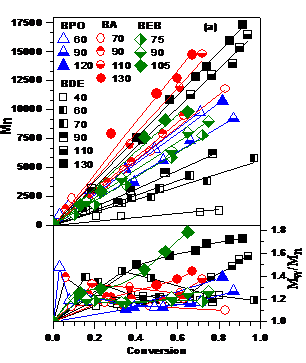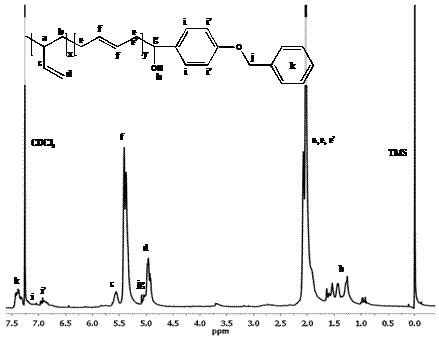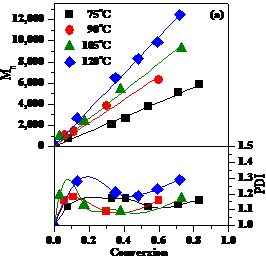Reports: AC7
47274-AC7 Early Transition Metal Catalyzed Living Radical and Ring Opening Polymerizations for Complex Copolymer Architectures
The initiation of a living radical polymerization by the Cp2TiCl mediated radical ring opening of epoxides, SET reduction of aldehydes, halide abstraction and redox reaction with peroxides (Scheme 1) was demonstrated not only for styrene but more importantly for dienes (butadiene, isoprene and 2,3, dimetylbutadiene) as well. While styrene and acrylates can be polymerized by other transition metals (e.g. Cu), the controlled metal mediated polymerization of dienes has never been disclosed. Thus, Cp2TiCl2 was shown to be the only transition metal catalyst that can provide their radical initiation from four different classes of initiators as well as a reversible trapping of the growing chain, leading to a living polymerization mechanism The advantages of epoxides and aldehydes rely on their commercial availability with a wide variety of chain ends and the in situ generation of alcohol chain ends which can be further employed in the synthesis of block copolymers, whereas the halide activation provided by Ti is superior to that afforded by Cu in ATRP since Ti can provide initiation even from inactivated alkyl halides.
Scheme 1: Mechanism of the Cp2TiCl-catalyzed styrene LRP initiated from epoxides, aldehydes, halides and peroxides.
All 4 Cp2TiCl-activated initiator types were thoroughly comparatively evaluated (Tetrahedron, 2008, 64, 11831) by investigating the effect of reagent stoichiometry (monomer to initiator, Ti/initiator, Zn/Ti) and temperature on initiator efficiency (IE) and polydispersity in the Cp2TiCl-catalyzed styrene LRP. While living polymerization features (linear dependence of molecular weight on conversion and low polydispersity) were obtained in most cases over a wide range of conditions, the comparison of the effect of the reaction variables revealed a set of initiator specific similarities and differences. For brevity only the effect of temperature is presented in Figure 1.
While the polymerizations are sensitive to the initiator structure, larger initiator efficiencies and narrower polydispersity (Mw/Mn ~ 1.2) are obtained with excess Cp2TiCl over initiator and of Zn over Cp2TiCl2, and with decreasing temperature. Therefore, optimum conditions which minimize PDI and maximize IE are [St]/[I]/[Cp2TiCl2]/[Zn] = (50-200)/1/(2-3)/(4-6) at 70-90 °C. However, they are also initiator dependent. Peroxides are good initiators, but do not provide functional chain ends. Halides are more sensitive to the variation in the reaction parameters and their optimum conditions are in a narrower interval. Finally, both epoxides and aldehydes remain synthetically the most useful. Epoxides may provide faster initiation and are more readily accessible on polymer backbones for the Ti-catalyzed synthesis of block and graft copolymers. However, aldehydes not only also allow access to the same PSt-OH functional chain ends but also seem to be the least affected by the reaction conditions and thus the most robust initiator in the series.
Figure 1. Effect of temperature in the Cp2TiCl-catalyzed styrene LRPs initiated from BDE, BA, BEB and BPO: (a) Dependence of Mn and Mw/Mn on conversion; (b) Dependence of IE and PDI on temperature.
The knowledge accumulated on styrene was further applied towards the isoprene and butadiene LRP since to date there is no example of a transition metal catalyzed diene LRP. We have thus provided the first example of such polymerizations using again the Cp2TiCl2/Zn system in conjunction with epoxides, aldehydes and halides and have shown that the polymerization is living, and that block copolymers with styrene can also be synthesized. (ACS Symposium Series, Controlled/Living Radical Polymerization. 2009, 1024, 149-166). In addition, a linear dependence on molecular weight on conversion was observed not only for isoprene as previously reported, but also for butadiene (Fig 3) while the initiation was demonstrated from e.g. benzyloxy benzaldehyde (Fig 4).
Figure 2. 500 MHz 1H-NMR spectra of isoprene/styrene copolymers synthesized by Cp2TiCl-catalyzed LRP.
Figure 3. The dependence of (a) Mn, Mw/Mn and (b) Ln(1/(1-c)) in the Cp2TiCl mediated butadiene polymerizations: [BD]/[BA]/[Cp2TiCl2]/[Zn] = 200/1/3/3, dioxane, 130 ºC.
Figure 4. 500 MHz 1H-NMR spectrum of polybutadiene initiated by BBA. [BD]/[BA]/[Cp2TiCl2]/[Zn] = 200/1/3/3, 130 ºC. MnGPC = 6,990; PDI = 1.58.
The first examples of the use of aldehydes in the living ring opening polymerization of e-CL were presented (J. Polym. Sci.: Part A: Polym. Chem. 2008, 46, 2869-2877, Scheme 2) via the use of the SET reduction of carbonyl groups to generate in situ Ti alkoxides.
Scheme 2. Living ring opening polymerization of caprolactone catalyzed by titanium alkoxides derived from SET reduction of aldehydes.
Figure 5. Temperature effect in the Cp2TiCl catalyzed caprolactone LROP (a) Dependence of Mn and PDI on conversion; (b) First order kinetics.
The living character of the polymerization was demonstrated (Fig. 2) by the linear dependence of Mn on conversion, low PDI values and linear kinetics, while the aldehyde initiation was confirmed (NMR) by the presence of the initiator fragment of the PCL chain end. The effect of the nature of the aldehyde functionality (R-Ph-CHO, R = H, Cl, PhCH2O, NMe2, CH3O, NO2, and CHO), reagent ratios ([CL]/[aldehyde] = 50/1 to 400/1, [aldehyde]/[Cp2TiCl2] = 1/1 to 1/4, [Cp2TiCl2]/[Zn] = 1/0.5 to 1/2) and temperature (T = 75 °C to 120 °C) was investigated over a wide range of values to reveal a living polymerization in all cases with an optimum observed at 90 °C with [CL]/[aldehyde]/[Cp2TiCl2]/[Zn]= 100/1/1/2.
Thus, together with epoxides, aldehydes were introduced as a new class of initiators for the Cp2TiCl-catalyzed living ROP of cyclic esters. This convenient and inexpensive novel methodology precludes the need for prior synthesis of air and moisture sensitive Ti complexes and provides convenient access to PCL with variety of chain ends derived from widely available and structurally diverse aldehyde precursors.
Current efforts are directed towards the application of the current methodologies in complex polymer architecture as well as the optimization of the LRP of dienes and the extension to main chain fluorinated monomers. Thus, it is envisioned that the concurrent radical and ring opening polymerization of styrene or dienes and respectively a cyclic ester can easily be achieved from e.g. an aldehyde which provides both a radical as well as a Ti alkoxide.














